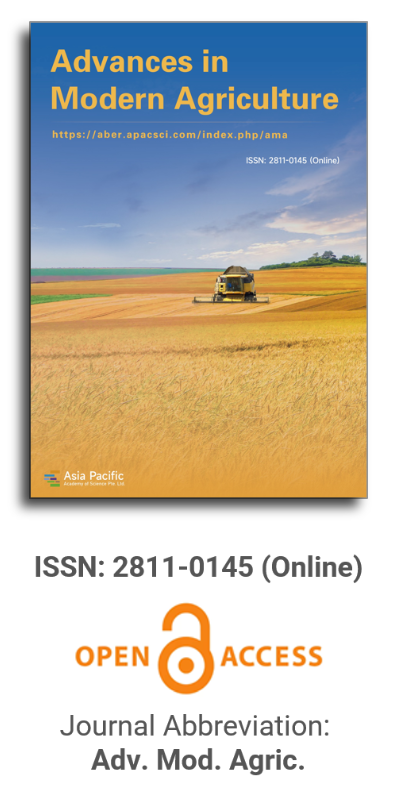


Herbicides Roundup (Glyphosate) and Paraquat (Gramoxone) as chemical ripeners for sugarcane variety SP70-1143 (A case study at Debel Khozaie Agro-Industrial Co.)
Vol 4, Issue 1, 2023
VIEWS - 3453 (Abstract)
Download PDF
Abstract
Keywords
References
- Marin FR, Rattalino Edreira JI, Andrade JF, et al. Sugarcane yield and yield components as affected by harvest time. Sugar Tech 2021; 23(4): 819–826. doi: 10.1007/s12355-020-00945-5
- McDonald L, Morgan T, Jackson P. The effect of ripeners on the CCS of 47 sugarcane varieties in the Burdekin. In: Proceedings of the 2001 Conference of the Australian Society of Sugar Cane Technologists; 1–4 May 2001; Mackay, Queensland, Australia.
- Legendre BL. Ripening of sugarcane: Effects of sunlight, temperature, and rainfall. Crop Science 1975; 15(3): 349–352. doi: 10.2135/cropsci1975.0011183x001500030020x
- Silva M, Caputo M. Ripening and the use of ripeners for better sugarcane management. In: Crop Management: Cases and Tools for Higher Yield and Sustainability. InTech; 2012. pp. 2–24.
- Clowes M. Early and late season chemical ripening of sugarcane. Proceedings of The South African Sugar Technologists’ Association 1978; 52: 160–165.
- Rostron H. Chemical ripening of sugarcane with Fusilade Super. Proceedings of The South African Sugar Technologists’ Association 1985; 59: 168–175.
- Morgan T, Jackson P, McDonald L, et al. Chemical ripeners increase early season sugar content in a range of sugarcane varieties. Australian Journal of Agricultural Research 2007; 58(3): 233. doi: 10.1071/ar06018
- Donaldson RA. Effects of ethephon applied to two sugarcane varieties to prevent flowering. Proceedings of The South African Sugar Technologists’ Association 1996; 70: 38–41.
- Dalley CD, Richard EP. Herbicides as ripeners for sugarcane. Weed Science 2010; 58(3): 329–333. doi: 10.1614/ws-d-09-00001.1
- Solomon S, Shahi HN, Duttamajumder S, et al. Effect of Ethephon on sugarcane grown under sub-tropical climates. Proceedings of International Society of Sugar Cane Technologists 2001; 24: 174–176.
- van Heerden PDR. Evaluation of Trinexapac-ethyl (Moddus®) as a new chemical ripener for the South African sugarcane industry. Sugar Tech 2013. doi: 10.1007/s12355-013-0278-x
- Millhollon R, Legendre B. Growth and yield response of Louisiana sugarcane cultivars to annual preharvest treatments with the ripener glyphosate. Sugar Cane International 2000; 18: 5–9.
- Resende PAP, Soares JE, Hudetz M. Moddus (R), a plant growth regulator and management tool for sugarcane production in Brazil. International Sugar Journal 2001; 103(1225): 2–6.
- Karmollachaab A, Bakhshandeh A, Moradi Telavat MR, et al. Sugarcane yield and technological ripening responses to chemical ripeners. Sugar Tech 2015; 18(3): 285–291. doi: 10.1007/s12355-015-0400-3
- Ayele N, Tana T, Van Heerden PDR, et al. Ripening response of sugarcane varieties to chemical ripeners and economic benefits during the early period of harvesting at Wonji-shoa and Metahara sugarcane plantations, Central Rift Valley of Ethiopia. International Journal of Agronomy 2021; 2021: 1–9. doi: 10.1155/2021/6645913
- Donaldson RA. Effects of various rates of Fusilade Super as a ripener on the sugarcane variety N-14. Proceedings of the South African Sugar Technologists’ Association 1989; 63: 167–173.
- Dusky J, Alvarez J. Optimal harvesting time after ripener application in sugar cane. Sugar Cane 1986; 5: 1–3.
- Bennett P, Montes G. Effect of glyphosate formulation on sugarcane ripening. International Sugar Journal 2003; 66: 22.
- Viator BJ, Viator C, Jackson W, et al. Evaluation of potassium-based ripeners as an alternative to glyphosate and the effects of 2,4-d on herbicidal cane ripening. The American Society of Sugar Cane Technologists Journal 2004; 24: 98–102.
- Leite GHP, Crusciol CAC. Crusciol, Growth regulators in the development and productivity of sugarcane. Pesquisa Agropecuária Brasileira 2008; 43(8): 995–1001. doi: 10.1590/s0100-204x2008000800007
- Viana RDS, Silva PH, Mutton MA, et al. Effects on the application of chemical ripeners on the culture of sugarcane (Saccharum spp.), SP81-3250 variety. Acta Scientiarum Agronomy 2008; 30(1). doi: 10.4025/actasciagron. v30i1.1130
- Staff SS. Keys to Soil Taxonomy, 12th ed. USDA-Natural Resources Conservation Service; 2014.
- Steel RG, Torrie JH. Principle and Procedures of Statistic: A Biometrical Approach. McGraw-Hill; 1980.
- Chen JC, Chou CC. Cane Sugar Handbook: A Manual for Cane Sugar Manufacturers and Their Chemists. John Wiley & Sons; 1993.
- Fernandes AC. Calculations in the Sugarcane Agroindustry (Portuguese), 3rd ed. STAB, Piracicaba; 2011.
- Vasconcelos JN. Ethanol ermentation (Portuguese). In: Santos F, Borém A, Caldas C (editors). Sugarcane Bioenergy, Sugar and Alcohol-Technologies and PerspectivesI (Portuguese). Suprema; 2010. pp. 401–403.
- Kingston G, Rixon CM. Ripening response of twelve sugarcane cultivars to MODDUS® (trin-exapac ethyl). In: Proceedings of the 2007 Conference of the Australian Society of Sugar Cane Technologists; 8–11 May 2007; Cairns, Queensland, Australia.
- Inman-Bamber N, Jackson P, Bonnett G, Morgan T. Have we reached peak CCS? International Sugar Journal 2011; 113: 798–803.
- BSES. Laboratory manual for Australian sugar mills, Volume 2. Available online: https://sugarresearch.com.au/sugar_files/2017/02/Milling-laboratory-manual.pdf (accessed on 8 June 2023).
- Kouamé KD, Péné BC, N’guessan AC, et al. Effect of glyphosate used as a sugarcane chemical ripener in Cte dIvoire. African Journal of Plant Science 2017; 11(8): 341–350. doi: 10.5897/ajps2017.1570
- Orgeron AJ. Sugarcane Growth, Sucrose Content, and Yield Response to the Ripeners Glyphosate and Trinexapac-Ethyl. Louisiana State University and Agricultural and Mechanical College; 2012.
- Orgeron A, Gravois K, Spaunhorst D. Sugarcane Ripener Recommendations for 2020. LSU AgCenter Sugar Research Station; 2020.
- Alexander A. Efficiency of chemical ripener action in sugarcane. v. superior efficiency of CP 70139 (Monsanto) in direct comparisons with Polaris. Journal of Agriculture of The University of Puerto Rico 1969; 61: 160–169.
Supporting Agencies
Copyright (c) 2023 Farideh Yarahmadi, Mohammad Mehdi Motiei, Lotfollah Abdollahi, Mojtaba Abdi Karamvand

This work is licensed under a Creative Commons Attribution 4.0 International License.

This site is licensed under a Creative Commons Attribution 4.0 International License (CC BY 4.0).

Prof. Zhengjun Qiu
Zhejiang University, China

Cheng Sun
Academician of World Academy of Productivity Science; Executive Chairman, World Confederation of Productivity Science China Chapter, China
Indexing & Archiving
In the realm of modern agriculture, the integration of cutting-edge technologies is revolutionizing the way we approach sustainable farming practices. A recent study published in Advances in Modern Agriculture titled "Classification of cotton water stress using convolutional neural networks and UAV-based RGB imagery" has garnered significant attention for its innovative approach to precision irrigation management. Conducted by researchers from Institute of Data Science and the AgriLife Research and Extension Center of Texas A&M University (authors's information is below). This study introduces a novel method for classifying cotton water stress using unmanned aerial vehicles (UAVs) and convolutional neural networks (CNNs), offering a powerful solution for optimizing water use in agriculture.
Modern agricultural technology is evolving rapidly, with scientists collaborating with leading agricultural enterprises to develop intelligent management practices. These practices utilize advanced systems that provide tailored fertilization and treatment options for large-scale land management.
This journal values human initiative and intelligence, and the employment of AI technologies to write papers that replace the human mind is expressly prohibited. When there is a suspicious submission that uses AI tools to quickly piece together and generate research results, the editorial board of the journal will reject the article, and all journals under the publisher's umbrella will prohibit all authors from submitting their articles.
Readers and authors are asked to exercise caution and strictly adhere to the journal's policy regarding the usage of Artificial Intelligence Generated Content (AIGC) tools.
Asia Pacific Academy of Science Pte. Ltd. (APACSCI) specializes in international journal publishing. APACSCI adopts the open access publishing model and provides an important communication bridge for academic groups whose interest fields include engineering, technology, medicine, computer, mathematics, agriculture and forestry, and environment.



.jpg)
.jpg)

.jpg)
